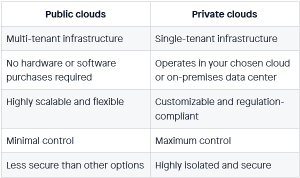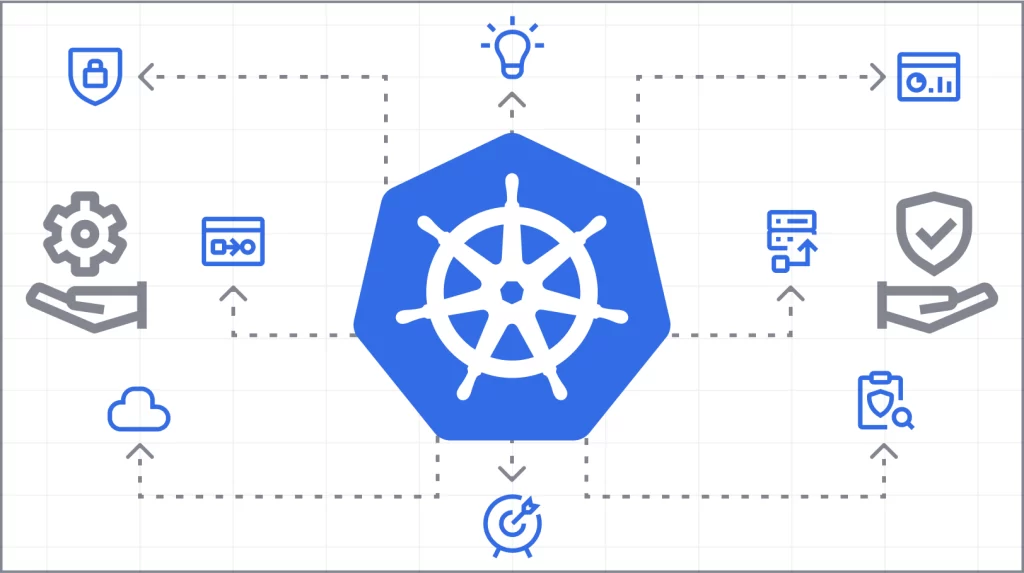Private vs. Public Clouds: Differences, Use Cases, and More
Common cloud deployment models
Cloud computing provides increased scalability, lower operational costs, better reliability, and faster connectivity than on-premises data centers alone.
The most common cloud deployment models are:
- A public cloud is shared with other organizations.
- A private cloud is isolated and hosted privately in your data center.
- A hybrid cloud combines public clouds, private clouds, and on-premises servers.
- A multi-cloud is a combination of public and private clouds.
Public cloud vs. private cloud comparison
A few main differences dictate public and private cloud use cases. More details about each option are below, but here’s a TL;DR comparison of public vs. private clouds:

What is a public cloud?
Public clouds run on a shared infrastructure managed and maintained by a third-party cloud provider, like:
- Amazon Web Services (AWS)
- Microsoft Azure
- Oracle Cloud
- Google Cloud Platform (GCP)
Your chosen cloud provider is responsible for all cloud management and operations. That covers:
- The infrastructure (virtual machines and applications)
- Storage
- Hosting
- Maintenance
- All computing resources
Public clouds can be flexible, too, giving you the freedom to scale up or down as necessary.
The cost of a public cloud is one of the reasons why it’s a standard deployment option for organizations. There’s no need to purchase new hardware or software, and pricing models are typically a subscription or pay-as-you-go plan where you only pay for what you use.
According to TechTarget, public clouds are sometimes called “utility computing” since their services — like water, gas, and electricity — are delivered on demand.
Benefits of public clouds
With your cloud operations under control, your organization can use the time, cost, and resource savings to focus on innovation and growth strategies. Other benefits include:
- Low maintenance
- No major upfront costs
- Flexible scaling
- Fewer wasted resources
- Consumption-based pricing
Drawbacks of public clouds
Since anyone can access it, a public cloud is less secure than a private cloud.
A private cloud is better if your organization handles sensitive information and requires more privacy than public cloud use cases. Examples of private cloud use cases can be found in financial, government, health industries.
What is a private cloud?
A private cloud is an isolated deployment option that a single organization accesses and controls.
With a private cloud, you can choose whether your data center resources are stored on-premises or with a third-party vendor. Most commonly, private clouds are deployed on-premises, which typically has a higher upfront investment than a public cloud.
You’ll also need to consider the amount of time and resources that will go into managing an on-premises infrastructure, as it can be a significant undertaking for your in-house IT team.
Alternately, third-party vendors — AWS, Google, Oracle, IBM, Microsoft, etc. — offer managed private cloud services in subscription pricing models that vary depending on the management level you need.
A key reason why you might prefer a private cloud is security. Hosting a workload on a public cloud’s shared infrastructure can be too risky for highly regulated industries with strict regulations and compliance practices — like government organizations, financial services, and healthcare facilities.
However, a private cloud operates in an isolated environment with resources that are only accessible to your organization, making it more secure than a public cloud.
Benefits of private clouds
The top benefits of private clouds include:
- Fully controlled by your organization
- Highly customizable with high visibility
- No shared infrastructure increases security
Since you own the hosting infrastructure and software with a private cloud, your organization has full control over all operations, configurations, security, management, and application development lifecycles.
You’ll also be able to manage the performance of your deployments since direct access to the hardware and server allows you to adjust resources.
Drawbacks of private clouds
The beauty of a private cloud is the amount of control you have, which means you’re responsible for all operations. A private cloud’s upfront costs and management might be too much for your organization if you don’t have an in-house DevOps team or the budget to hire and train one.
What is a hybrid cloud?
A hybrid cloud strategy combines public clouds, your private cloud, and your on-premises setup. All cloud services work together, share data and processes, and are managed in one computing environment.
For example, you might use the public cloud’s resources to handle increases in network traffic for certain apps while your private cloud or on-premises system complies with regulations for data security.
Benefits of hybrid clouds
A hybrid strategy offers the best of both clouds and leverages the benefits of your existing infrastructure. Other key benefits include:
- Flexible operations and scaling
- Unified management for all services in a single platform
- Workload portability
Drawbacks of hybrid clouds
With various cloud services from different providers, there are additional complexities in maintaining a hybrid cloud. In-house installation, management, and maintenance expenses can quickly add up, and there may be more security risks with data moving between services.
What is multi-cloud?
A multi-cloud strategy involves a combination of public clouds and private clouds. Sound familiar? Multi-clouds and hybrid clouds are often used interchangeably, but the plans differ.
Unlike a hybrid approach, a multi-cloud strategy does not share data and processes across services and manages vendors separately. Instead, multi-cloud is intended for a siloed workload for a specific team or department. Also, multi-cloud strategies don’t often include on-premises systems.
Benefits of multi-cloud
The benefits of multi-cloud include:
- The ability to use various cloud services for different departments
- The flexibility to easily switch between vendors
- Less downtime with strategically located data centers
Drawbacks of multi-cloud
Migrating to a multi-cloud strategy and managing multiple vendors can be time-intensive and complex. Also, your multi-cloud operations stay siloed, meaning data is not transferred between services. But depending on your needs, this might be a benefit.
Another drawback is the need for your IT team to have the knowledge and skill sets to handle maintenance for multiple cloud deployment methods.
Public vs. private vs. multi-cloud vs hybrid cloud
Is your destiny in one of the clouds or a server down here on Earth? The answer depends on many factors, from security and control to use cases and restrictions.
It’s important to note that modern-day organizations rarely rely on just one cloud deployment option. A study by Flexera found that 87% of organizations use a multi-cloud strategy, while 72% use a hybrid approach.
Before you embark on your cloud deployment strategy, consider the following questions:
- How much control do you need over your cloud operations?
- Do you have sensitive data and strict compliance standards and regulations?
- Do you have the budget, staff, and resources to manage everything in-house? Or will you need a third-party management partner?
- What levels of performance and reliability do you need?
Bài viết cùng chủ đề:
-
Leave Request – Quản lý nghỉ phép thông minh trong một mô-đun CRM duy nhất
-
Techworld Solutions Đồng Hành Cùng UTE Trong Đào Tạo Nhân Lực Chất Lượng Cao
-
Microsoft Office chính thức chuyển thành Microsoft 365
-
Epicor Asia & Techworld Solutions Vietnam Chính Thức Công Bố Quan Hệ Đối Tác Chiến Lược, Mở Rộng Hệ Sinh Thái Giải Pháp Tại Việt Nam và Khu Vực
-
Chúc mừng đội ngũ Microsoft!
-
Giá trị của Microservices Doanh Nghiệp với Low-Code
-
Sự Tiến Hóa Tiếp Theo Của Mendix Cloud: Đón Nhận Kubernetes Để Xây Dựng Nền Tảng Sẵn Sàng Cho Tương Lai
-
Optimizing Production with Epicor ERP – Specialized Solutions for Complex Industries
-
Addressing the Knowledge Gap
-
AI-Assisted Development in Action with Mendix
-
Empowering Mobile Innovation
-
How to Upgrade Legacy Systems to Compete in the Cloud Age
-
TECHWORLD SOLUTIONS VIỆT NAM VÀ ĐẠI HỌC SPKT ĐÀ NẴNG KÝ KẾT HỢP TÁC TRIỂN KHAI TRUNG TÂM NGHIÊN CỨU & ĐÀO TẠO CÔNG NGHỆ SỐ
-
How to Architect Your Mobile Customer & Employee Experiences
-
PVI Gia Định Partners with Techworld Solutions Vietnam to Revolutionize Insurance Management
-
ESEC Group Partners with Techworld Solutions Vietnam to Implement Microsoft Dynamics 365 ERP

















